Yellowstone National Park

Established as the world's first national park on March 1, 1872, Yellowstone is a huge National Park that spans over 3,468 square miles. The park itself is centered over the Yellowstone Caldera, North America's largest supervolcano, which comprises more than a third of the park. Boasting an impressive array of geothermal features, including the world's tallest active geyser, and home to a diverse range of mammals, the park draws millions of visitors every year. As the centerpiece of the Greater Yellowstone Ecosystem, the park provides boundless recreational opportunities.
History of Yellowstone National Park
Yellowstone National Park, the first national park ever, was established by the 42nd U.S. Congress with the Yellowstone National Park Protection Act, and was signed into law by President Ulysses S. Grant on March 1, 1872. However, the human history of the park extends much further back, as Native Americans began hunting and fishing in the region at least 11,000 years ago. The cultural history has been documented by over a thousand archaeological sites found within the park, along with 1,106 historic structures and features, including Obsidian Cliff and five buildings which have been designated National Historic Landmarks.
The park's administration was transferred to the National Park Service in 1917, after the arrival of automobiles had already begun to shape the park's usage with about 1,000 cars entering annually by 1915.
Yellowstone is renowned for its wildlife, such as the black bears that became a symbol of the park from 1910. Despite initially allowing and even encouraging visitors to feed the bears, the park changed this policy in 1970 to prevent dangerous interactions and protect the park's ecology.
Another significant achievement for the park was the successful wolf reintroduction program started in the 1990s. Almost all wolves present in the park today are descendants from the 66 wolves reintroduced in 1995–96. As of 2005, the park supported 13 wolf packs, totaling 118 individuals.
The park faced a significant challenge in June 2022 when record rainfall and flooding led to evacuations and temporary closure. Reopening was accomplished in stages with restrictions on car entry to manage the heavy summer visitor load. Despite these challenges, the park continues to draw millions of visitors from around the world.
Yellowstone National Park Timeline
- 11,000 years ago: Human presence in Yellowstone region begins.
- Late 1860s: Organized exploration of the region begins.
- 1872: Yellowstone is established as the first national park.
- 1880: Harry Yount appointed as park's first gamekeeper.
- 1910: Park's black bears become a symbol of Yellowstone.
- 1915: The park starts to see a significant increase in visitors with 1,000 automobiles entering annually.
- 1917: Park administration transferred to the National Park Service.
- 1970: Visitor interactions with bears restricted to protect ecology.
- 1978: Yellowstone is named a UNESCO World Heritage Site.
- 1990s: Wolf reintroduction program begins.
- 2005: Survey reports 13 wolf packs with 118 individuals in Yellowstone.
- 2022: Record rainfall and flooding leads to park closure and evacuation.
How to get to Yellowstone
Yellowstone is a huge park with five entrances that can be a couple of hours of driving away from each other. The best way to enter the park depends on which entrance you are using.
North Entrance
The North Entrance is near Gardiner, Montana and is the only exit open year round for motorized vehicles. The Roosevelt Arch is at this entrance, which was constructed in 1903 to mark the entrance to Yellowstone park.
The Yellowstone Heritage and Research Center, is also in Gardiner near this entrance. This is mostly a research and storage facility, but they do have a small, frequently changing exhibits in the lobby that are open to the public.
The North Entrance is the closest entrance to the Mammoth Hot Springs, Mammoth Hot Springs Hotel and Cabins, and the Albright Visitor Center – it takes about 15 minutes by car. It is also just over an hours drive to the Grand Canyon of the Yellowstone.
This entrance is about 78 miles (125km) from Bozeman, Montana and takes about 80 minutes to drive.
Bozeman Yellowstone International Airport (BZN) has flights to Atlanta (ATL), Burbank (BUR), Chicago (ORD), Dallas/Ft. Worth (DFW), Denver (DEN), Last Vegas (LAS), Los Angeles (LAX), Minneapolis/St. Paul (MSP), Nashville (BNA), Phoenix (AZA), Portland (PDX), Seattle (SEA), Salt Lake City (SLC), and San Francisco (SFO). It also has seasonal flights to Austin (AUS), Boston (BOS), Dallas (DAL), Detroit (DTW), Houston (IAH), New York (JFK), Newark (EWR), Orange County (SNA), sand Diego (SAN), and Washington D.C. (IAD).
Northeast Entrance
The Northeast Entrance is located near Silver Gate, Montana and Cooke City Montana.
This is the closest entrance to the Lamar Valley (about 20 minutes), and is about 80 minutes away from the Grand Canyon of the Yellowstone.
This entrance is about 131 miles (211km) from Billings, Montana and takes about 2 hours and 45 minutes to drive.
Billings Logan International Airport (BIL) has flights to Denver (DEN), Dallas (DFW) , Minneapolis (MSP), Salt Lake City (SLC) , Seattle (SEA), Las Vegas (LAS), Phoenix (AZA). It also has seasonal flights to Chicago (ORD).
South Entrance
The South Entrance is near Grand Teton National Park and is about 57 miles (92km) from Jackson, Wyoming. To get to the park from Jackson, you need to drive through the Grand Tetons National Park and you might have to pay an entrance fee.
Jackson Hole Airport (JAC) has flights to numerous cities, including Dallas / Fort Worth, Denver, Salt Lake City, San Diego, San Francisco, Seattle, Atlanta, Chicago, Houston, Los Angeles, Minneapolis, and Newark.
From this entrance, it is about a 1 hour drive to Old Faithful.
East Entrance
The East Entrance is about 52 miles (84km) from Cody, Wyoming and takes about 1 hour to drive.
Yellowstone Regional Airport in Cody, Wyoming is near this entrance and currently has flights to Denver (DEN).
This is the closest entrance to Lake Yellowstone (about 30 minutes) and is about a 1 hour drive to the Grand Canyon of the Yellowstone.
West Entrance
The West Entrance is near West Yellowstone, Montana. Some nearby cities are:
- Bozeman, Montana, which is about 90 miles away and takes about 1 hour and 45 minutes to drive
- Idaho Falls, Idaho which is about 108 miles and also takes about 1 hour and 45 minutes to drive.
- Jackson, Wyoming which is about 127 miles and takes about 2 and a half hours to drive.
The following airports are near this entrance:
- Yellowstone Airport (WYS) in West Yellowstone is the closest airport and has seasonal flights to Salt Lake City and Denver.
- Idaho Falls Regional Airport (IDA) has flights to Seattle (SEA), Portland (PDX), Orange County (SNA), Las Vegas (LAS), Phoenix (PHX and AZA), Dallas-Fort Worth (DFW), and Denver (DEN). It also has seasonal flights to Minneapolis–Saint Paul (MSP), San Diego (SAN), and Oakland (OAK).
- Jackson Hole Airport (JAC) has flights to numerous cities, including Dallas / Fort Worth, Denver, Salt Lake City, San Diego, San Francisco, Seattle, Atlanta, Chicago, Houston, Los Angeles, Minneapolis, and Newark.
This entrance is about 27 minutes to Gibbon Falls, about 50 minutes to Old Faithful, and about 1 hour to the Grand Canyon of the Yellowstone.
Getting Around Yellowstone
There is no public transportation in the park. Getting around by car is the best option. The speed limit is 45 mph unless otherwise posted. There are frequent traffic jams due to wildlife crossing (or just standing) in the road.
At the time this article was written, there were:
- service stations in Canyon Village, Fishing Bridge, Grant Village, Mammoth Hot Springs, Old Faithful, and Tower Junction that were open 24 hours, year round for credit card fueling. More information can be found here.
- EV charging stations inside the park at Mammoth Hot Springs, Old Faithful, Canyon Village, and Lake Village. There are also charging stations outside the park in Gardiner and West Yellowstone. More information can be found here.
Things to do in Yellowstone National Park
Yellowstone National Park is enormous and you could spend a lifetime (or at least a long time) trying to see them all. Here are a small number of suggestions:
Geysers
Yellowstone has the largest concentration of geysers in the world. HALF of the world's geysers are in Yellowstone. There are about 1200+ geysers that have erupted in Yellowstone, and of those, around 465 are active in any given year.
The park has many geyser basins spread across the park – one of the great things about Yellowstone is walking or driving and seeing a random geyser eruprt.
Old Faithful

Old Faithful is probably the most famous geyser in the world. The area around Old Faithful has a lot of amenities, including parking, hotels, a visitor center.
Because the Geyser is famous, it attracts a large crowd. The park provides a lot of benches to sit on around the Geyser, but they fill up fast. Because it erupts regularly, it's possible to get there early to get a seat without waiting a long time.
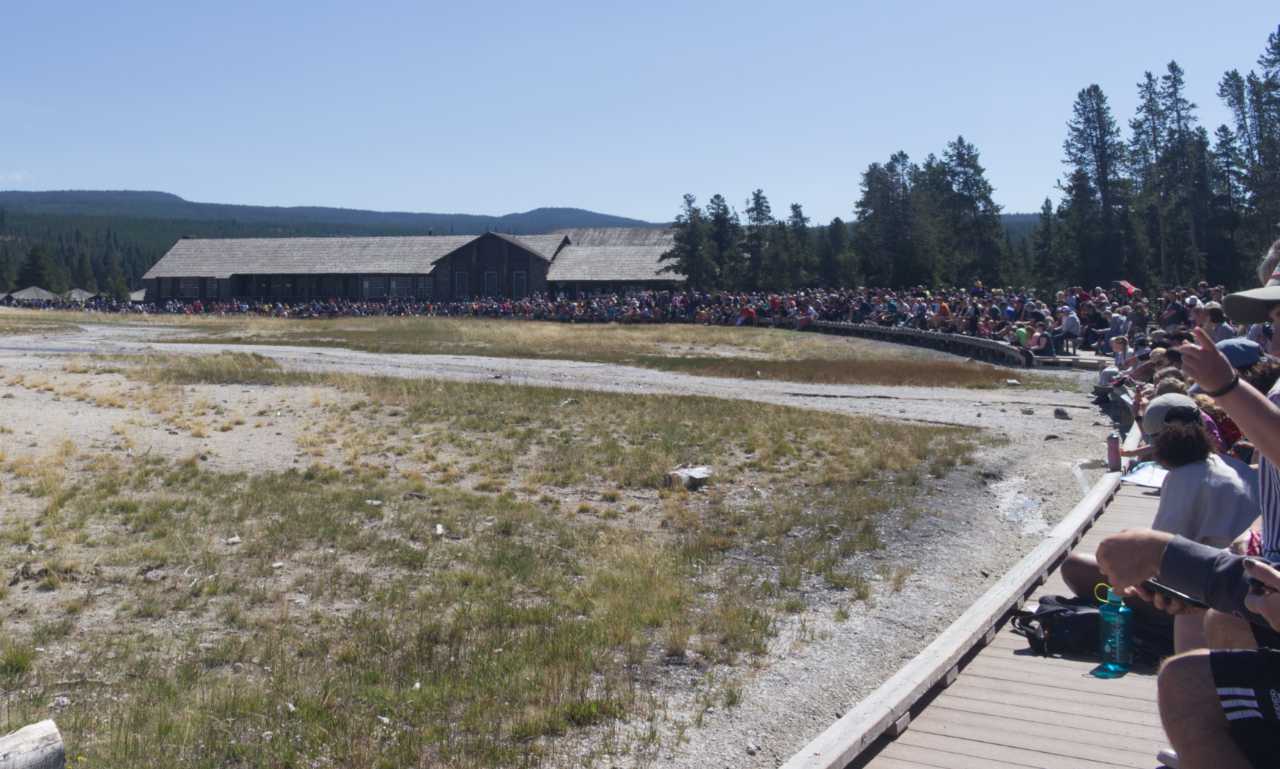
Norris Geyser Basin
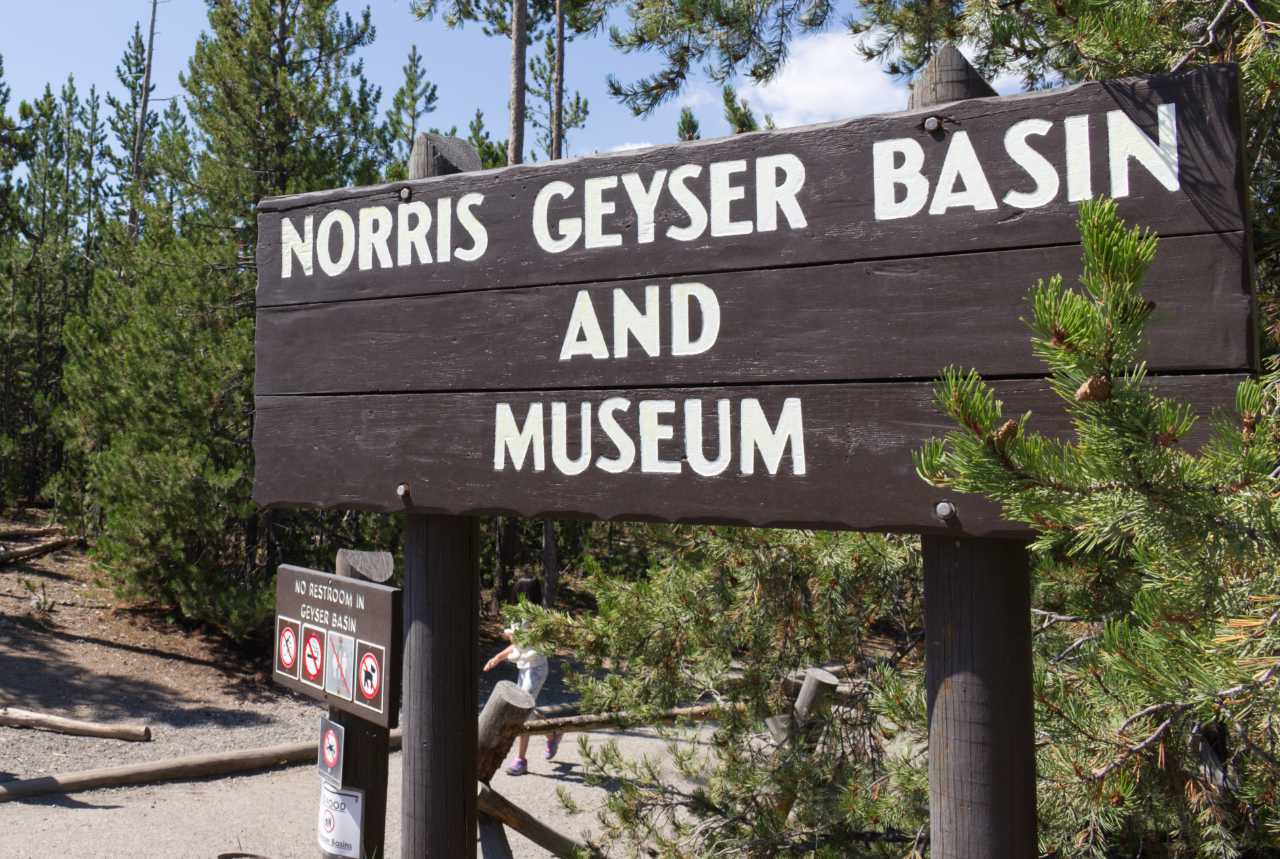
Norris Geyser Basin has about 193 geysers, a parking lot, and a museum.
Steamboat Geyser

Steamboat Geyser in Norris Geyser Basin is the tallest in the world at between 300 and 400 feet tall (90-120m). Unfortunately, this geyser does not erupt regularly – there can be months or years between eruptions.
Crackling Lake
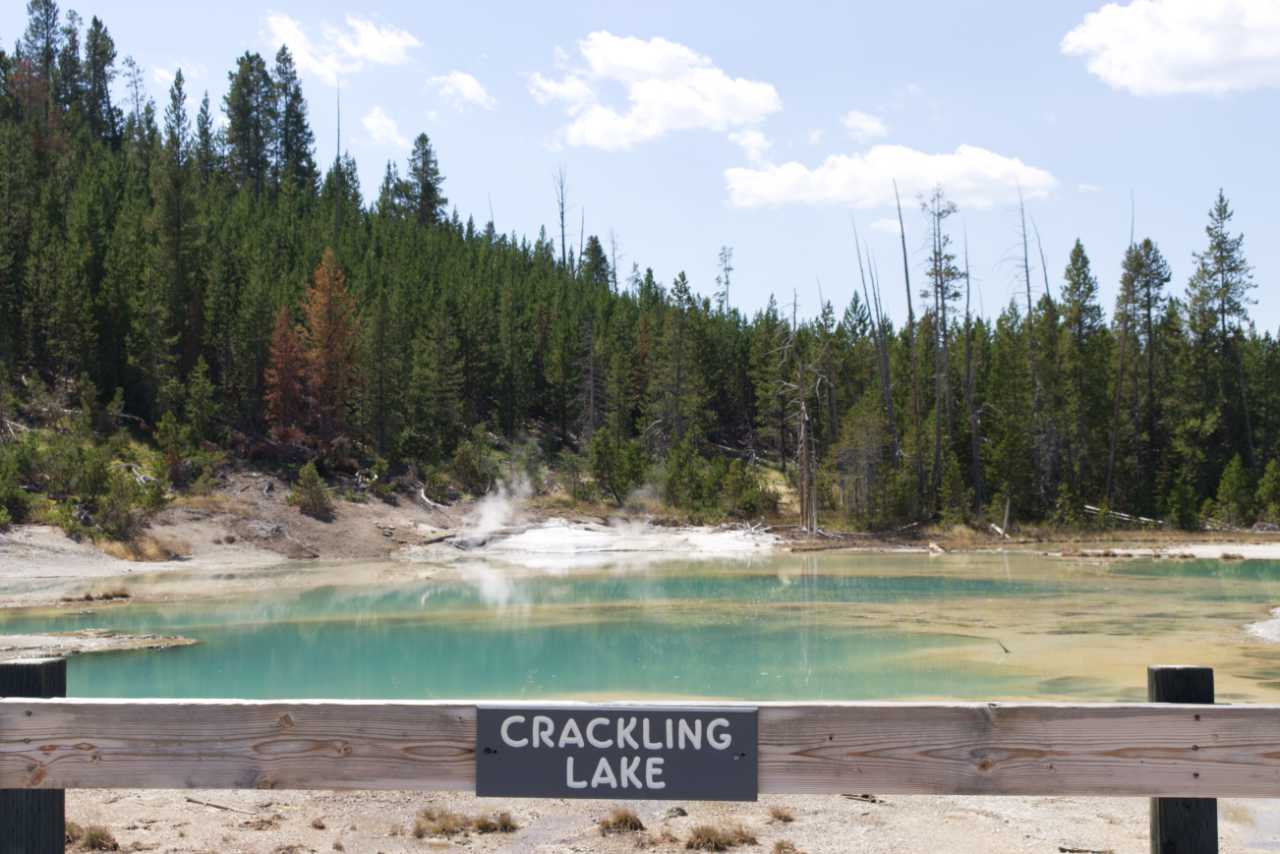
Crackling Lake, also in the Norris Geyser Basin gets its name from the sound it makes.
White Dome Geyser
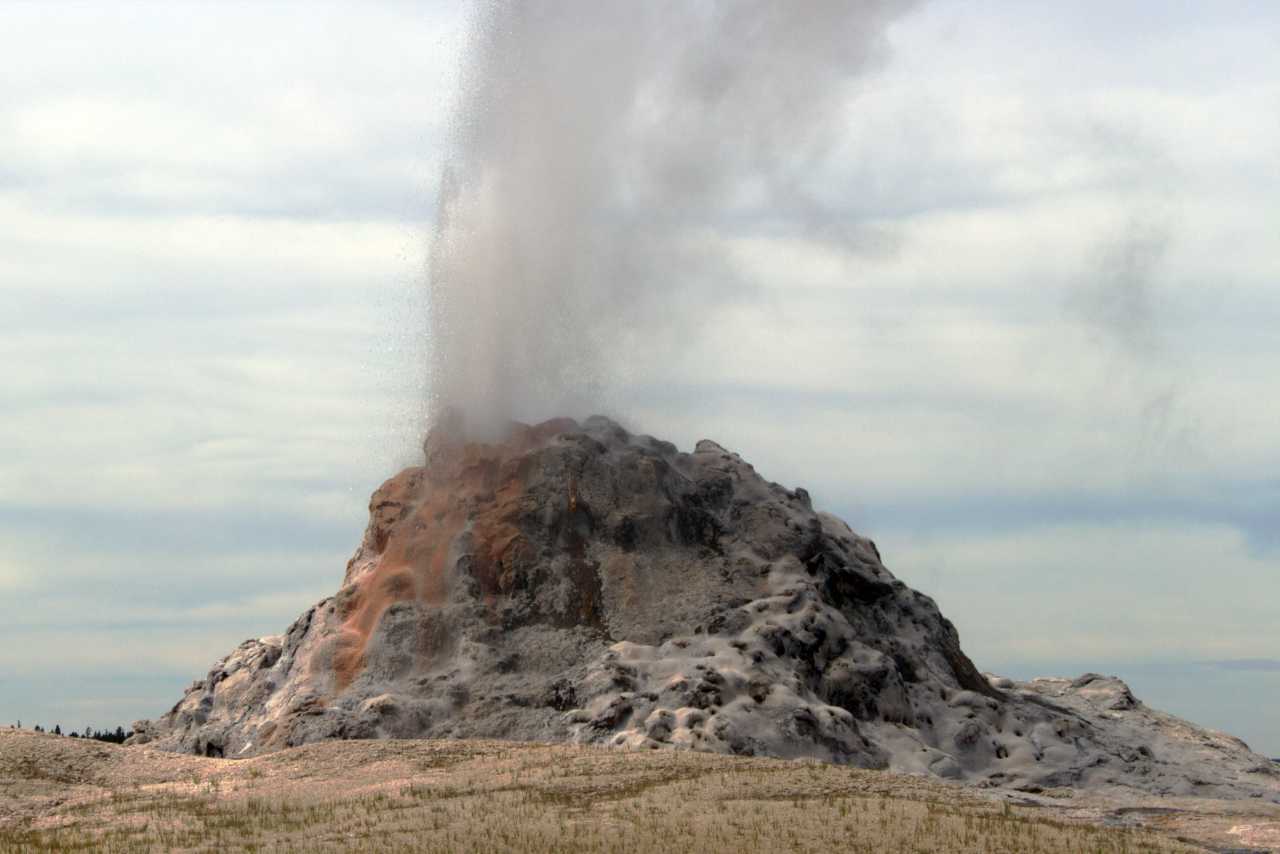
White Dome Geyser is in the Lower Geyser Basin in Yellowstone National Park. It's eruptions are unpredictable, but fairly frequent (between 15 minutes and 3 hours) and the crowds aren't as big as they are around Old Faithful.
Mammoth Hot Springs
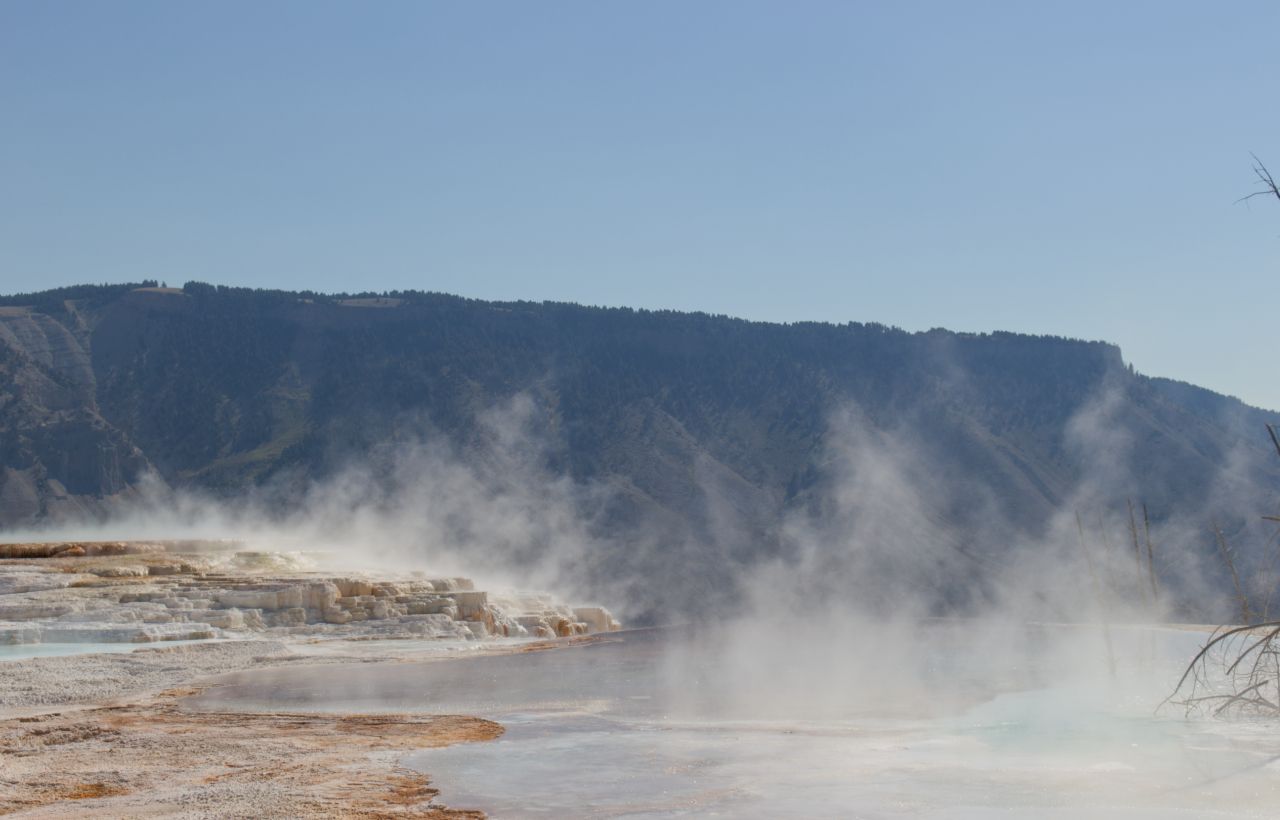
The Mammoth Hot Springs are a large collection of hot springs near the town of Mammoth in Yellowstone national park. Boardwalks are provided to safely explore the hot springs.
The Mammoth Hot Springs Hotel and Cabins and the Albright Visitor Center are here, along with a gas station and general store. There is plenty of parking here as well.
This area is accessible by car all year round.
Grand Canyon of the Yellowstone
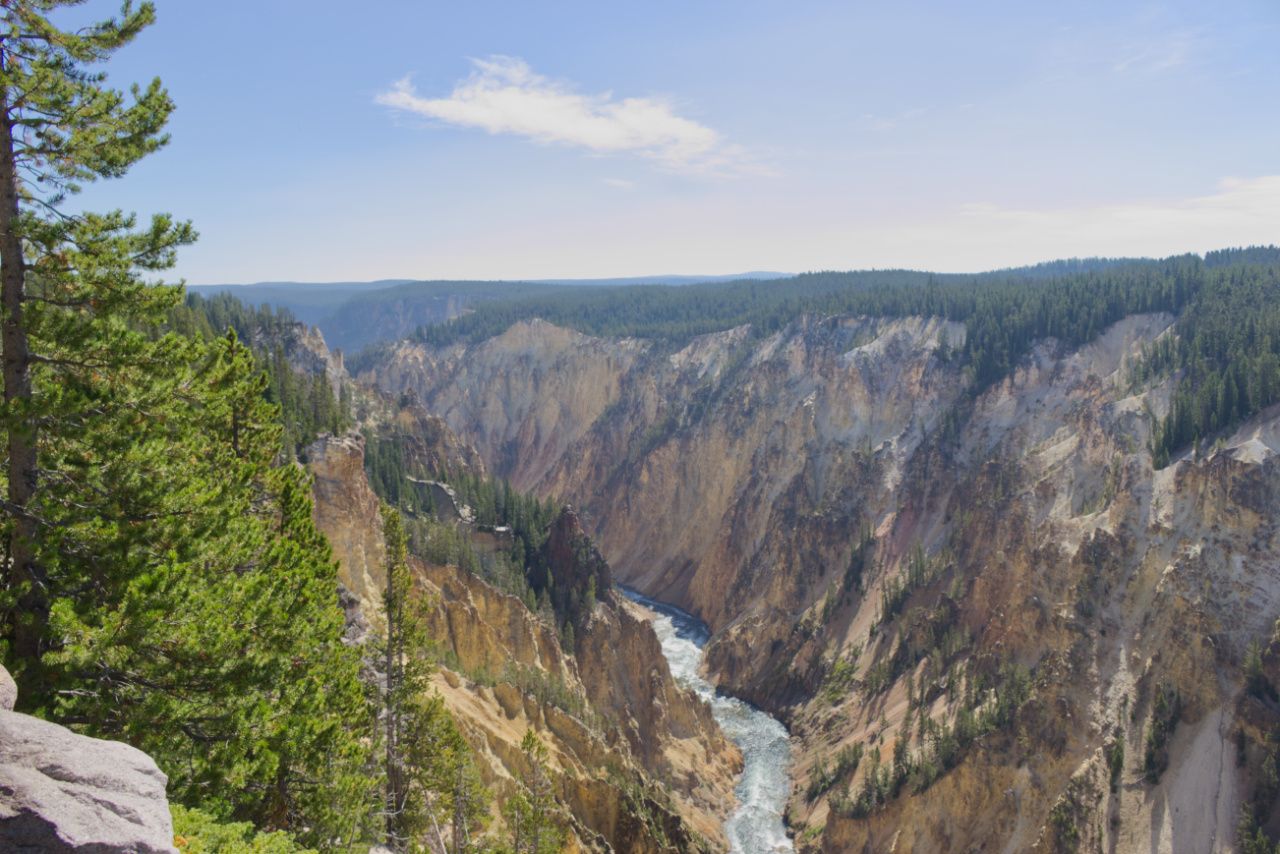
The Grand Canyon of the Yellowstone is a large canyon carved out by the Yellowstone River. The canyon is 24 miles (39km) long and up to 1200 feet (366m) deep. Both the North Rim Drive and South Rim Drive provide access to pullouts, parking areas, and viewpoints where you can see the canyon.
Waterfalls
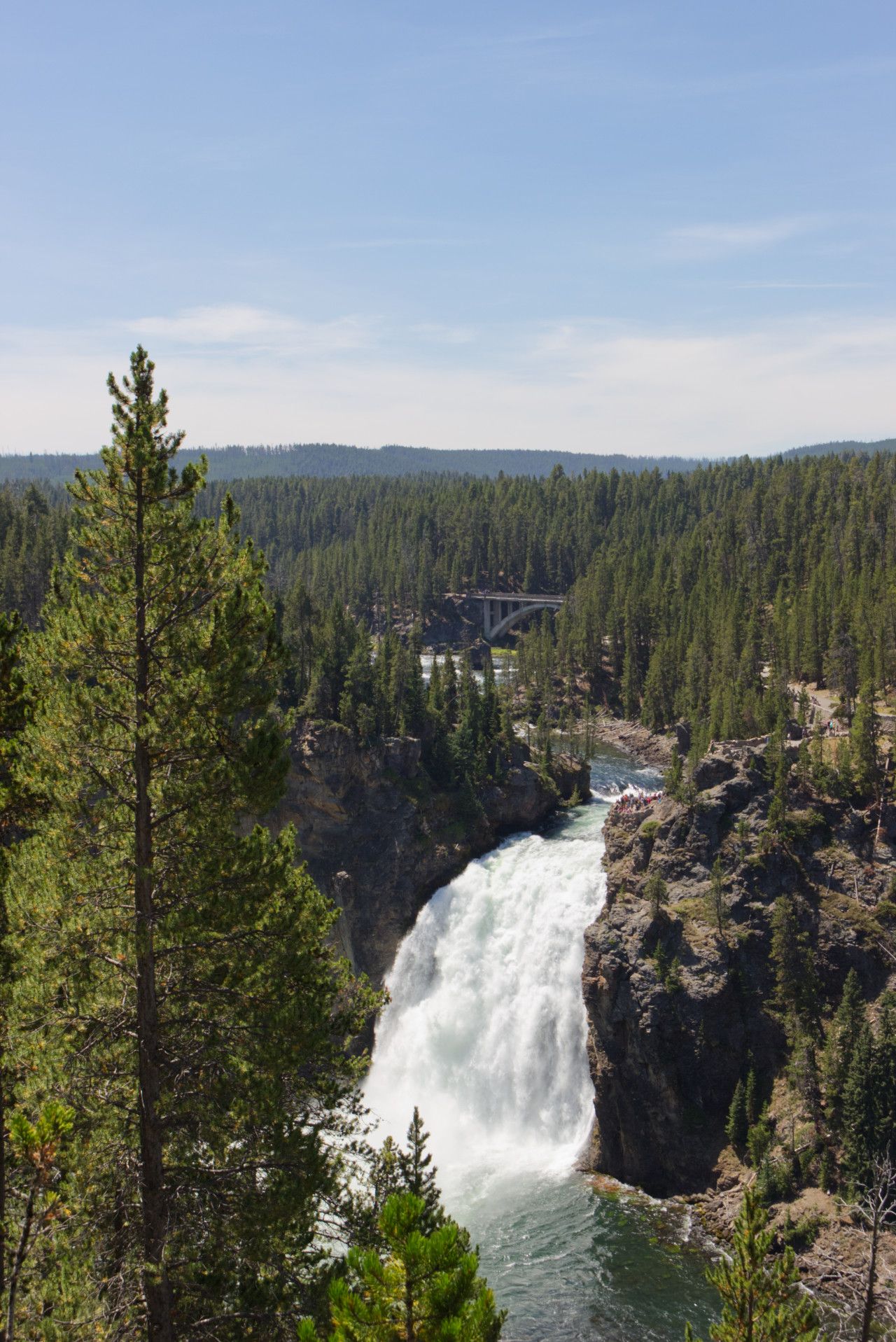

Yellowstone National Park has hundreds of waterfalls, many of which are easily accessible.
Yellowstone Lake
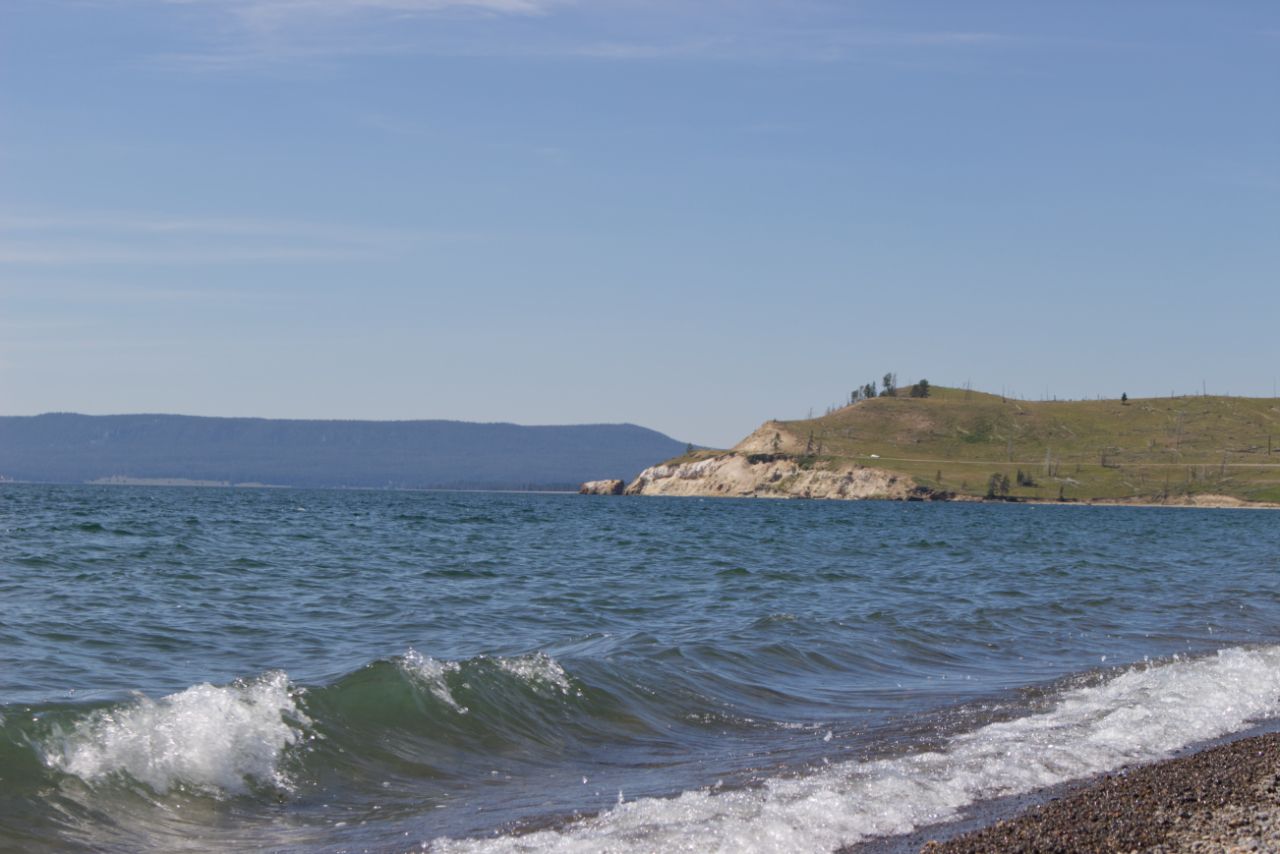
Yellowstone Lake is a high altitude lake 7,733 feet (2,357 m) above sea level and covers 136 square miles (350km) with 110 miles (180km) of shoreline. The lake is almost 400 feet (122m) deep at its deepest point.
The lake itself is centered over the Yellowstone Volcano Caldera.
Grand Prismatic Spring
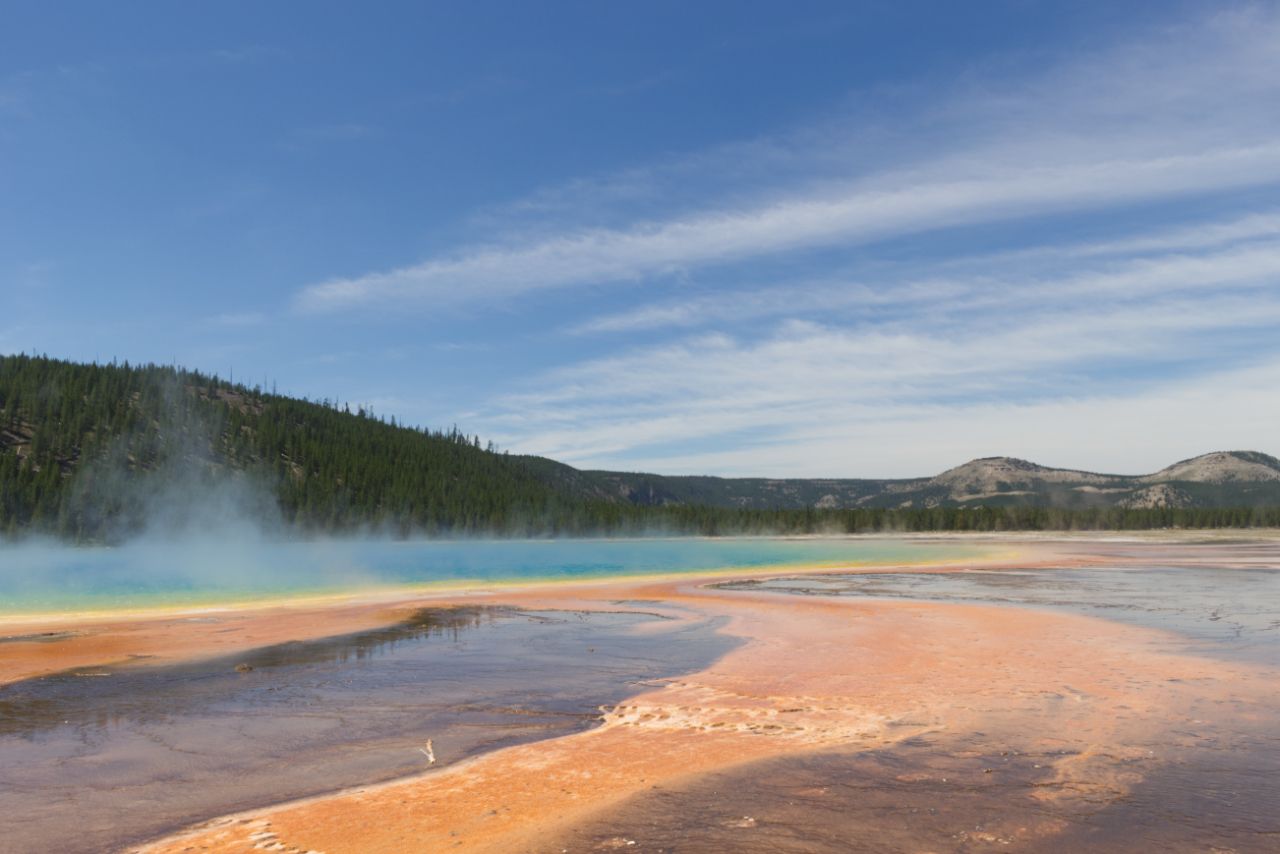
The Grand Prismatic Spring is located in the Midway Geyser Basin in Yellowstone National Park and full of bright orange, yellow, green, and blue colors. This is also the largest hot spring in the United States.
Wildlife

Yellowstone National Park is home to an impressive variety of mammals, reptiles, amphibians, and birds. Among its nearly 60 mammalian species, the park has wolves, coyotes, lynxes, cougars, black and grizzly bears, bison, elk, moose, and a several deer species. The Yellowstone Park bison herd is one of only four free-roaming and genetically pure herds left on public lands in North America. A 2005 survey highlighted the presence of 13 wolf packs totaling 118 individuals within the park, and over 30,000 elk – the largest population of any large mammal species in Yellowstone. Tthe park is also home to seven reptile and four amphibian species, along with 311 bird species.
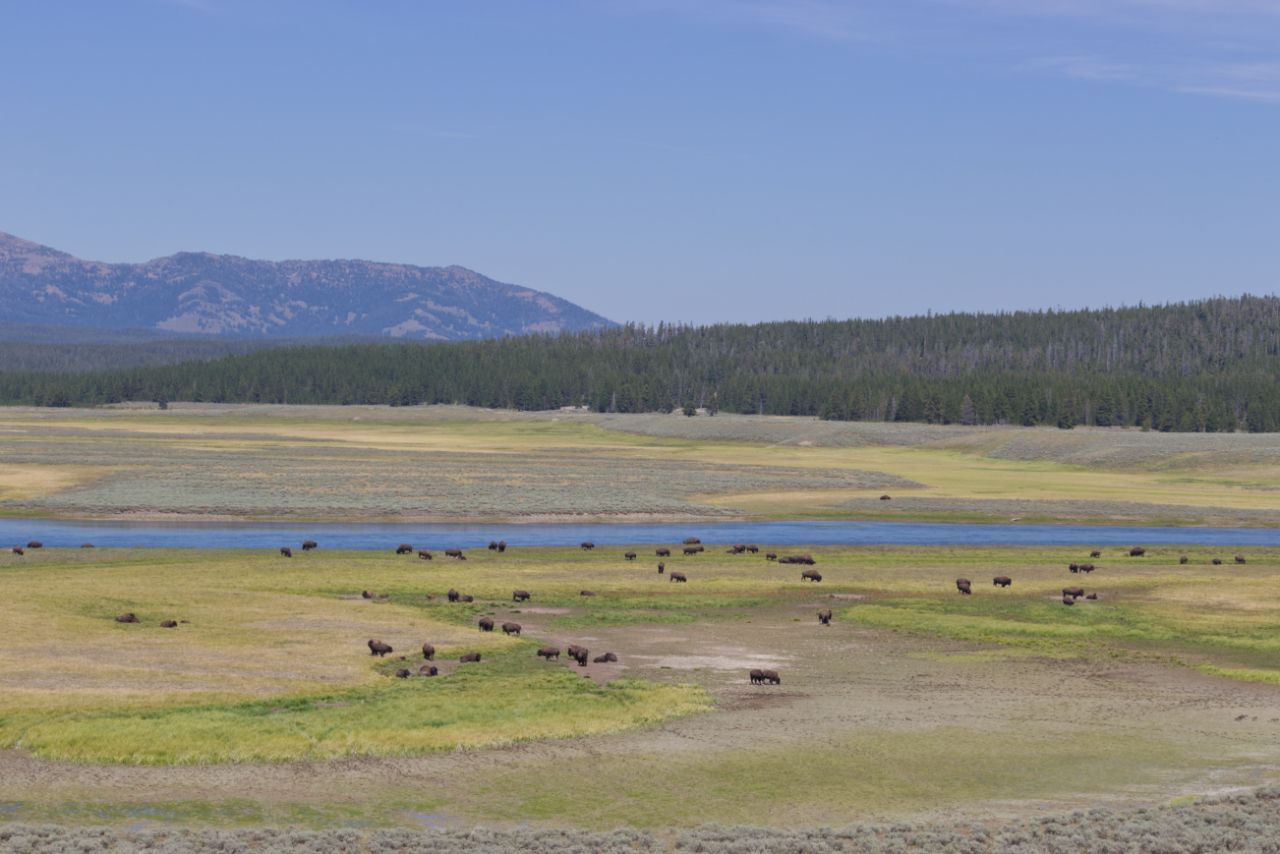
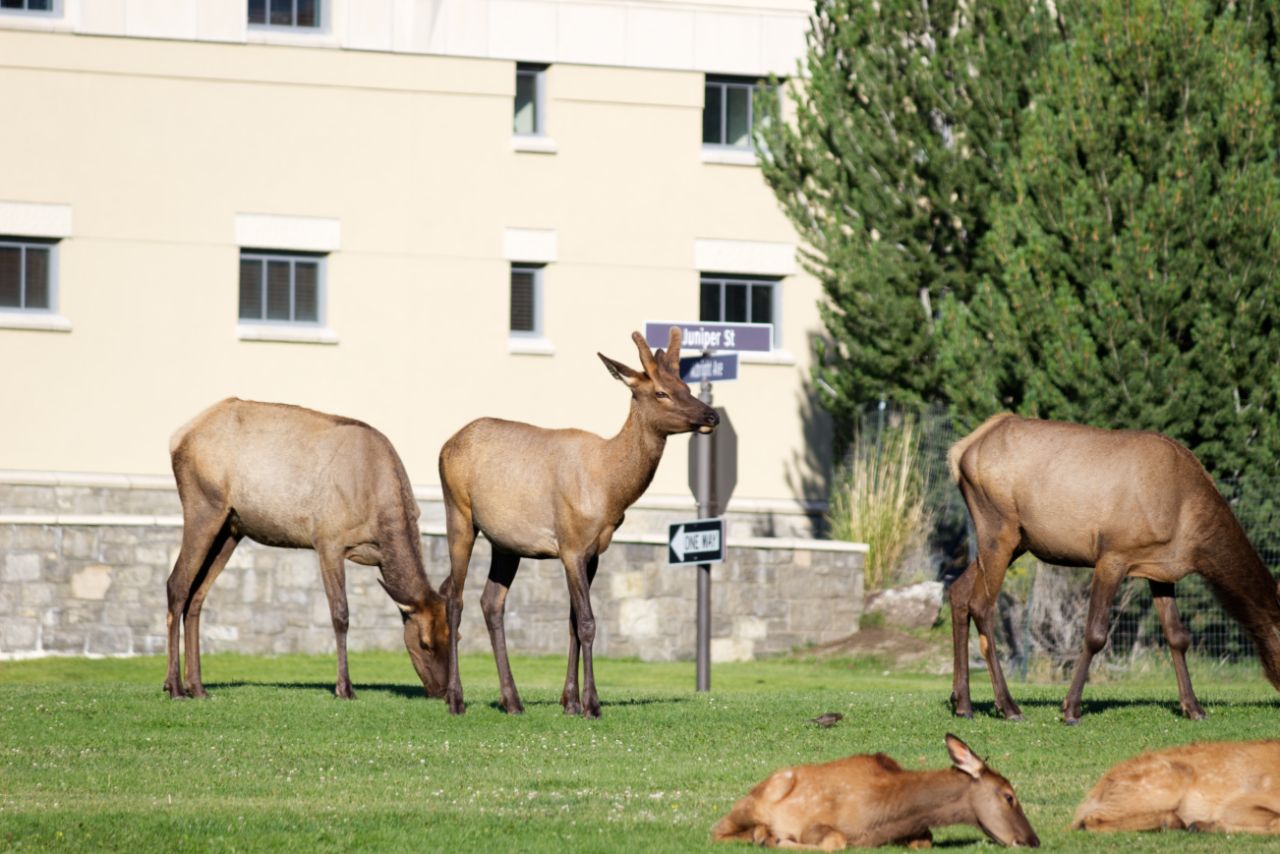
Fishing
Fishing is a popular activity in Yellowstone, with eighteen species of fish that live in the park. Fishing requires a Yellowstone National Park Fishing Permit. All native fish are catch and release only and must be released unharmed. Depending on the area, there is no limit for non-native fish.
Stargazing
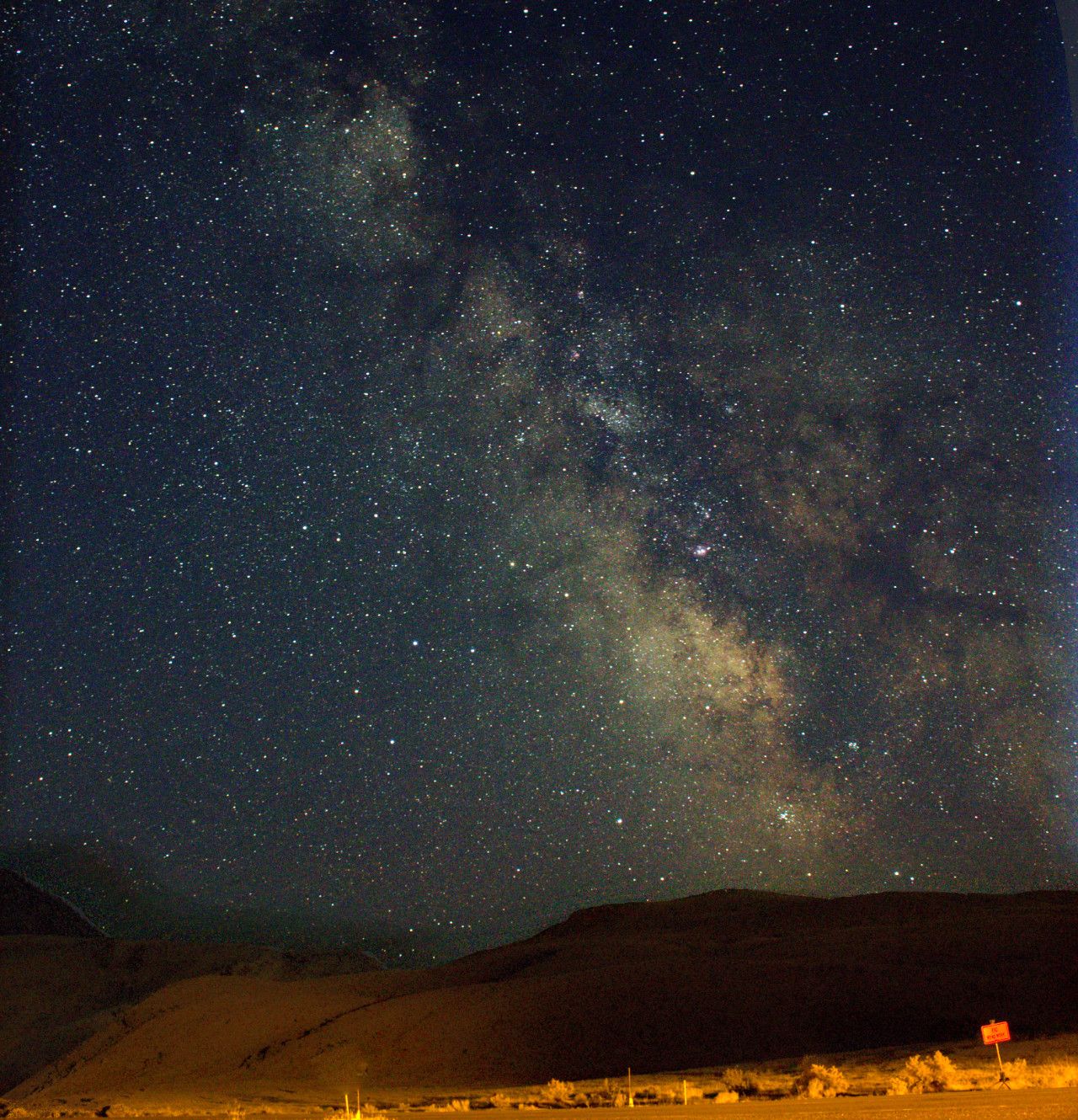
Yellowstone National Park is a great place for stargazing with very little light pollution. Most of the park is a bortle class 1, with a few areas near the North and West entraces a bortle class 2. Which means the park is very dark.
Things NOT to do in Yellowstone National Park
Hunting
Hunting is not allowed within Yellowstone itself, but it is allowed in the national forests and private land (with permission) surrounding the park.
Swimming
Swimming is generally not recommended because of the extremely cold water, although swimming is permitted at the Firehole Swim Area. Swimming or soaking is not allowed in any hydrothermal feature.
Getting too close to the animals
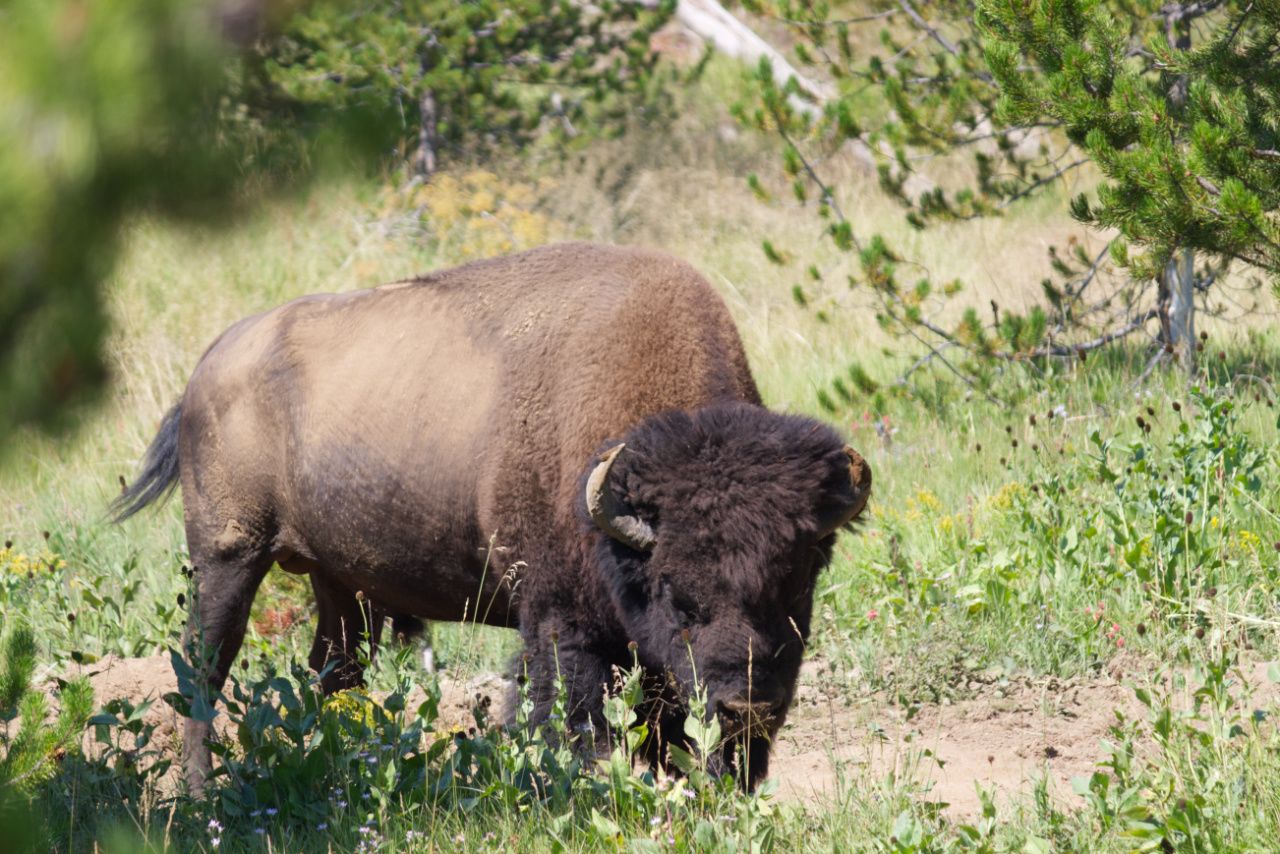
The wildlife in Yellowstone can be very dangerous and unpredictable. The park recommends that you stay at least 100 yards (91 m) away from bears and wolves, and at least 25 yards (23 m) away from all other animals, including bison and elk.
- You should not attempt to pet bison.
- Or attempt to take bison for a car ride.
Where to stay when visiting Yellowstone National Park
Inside the park
Hotels inside of Yellowstone National Park
- Roosevelt Lodge Cabins - open during the summer. No internet service. No AC, TV, or radio. Cooking is not allowed. No telephone in some cabins.
- Old Faithful Snow Lodge - open most of the year. Laundry facilities.
- Old Faithful Lodge Cabins - open during the summer. Some cabins do not have a bathroom. No internet service. No AC, TV, telephone, or radio. Cooking is not allowed.
- Old Faithful Inn - open during the summer. No internet. Some rooms do not have a bathroom.
- Mammoth Hot Springs Hotel and Cabins - open most of the year. Some rooms do not have bathrooms.
- Lake Yellowstone Hotel and Cabins - open during the summer and early fall. Has wired internet in rooms.
- Lake Lodge Cabins - open during summer and early fall. No internet service. No AC, TV, telephone, or radio. Cooking is not allowed. Laundry facilities.
- Grant Village - open during summer and early fall. No internet service. No AC, TV, or radio.
- Canyon Lodge and Cabins - open during summer and early fall.
Camping in Yellowstone National Park
There are 12 campgrounds with over 2,000 campsites inside Yellowstone National Park. All campgrounds welcome RVs with size limitations.
- Bridge Bay - has 432 sites. Has a dump station. Max RV+vehicle length is 60ft.
- Canyon - has 273 sites. Has a dump station. Max RV+vehicle length is 40ft
- Fishing Bridge RV Park - has 310 sites. Has a dump station. Has full RV hookups. Max RV+vehicle length is 40ft.
- Grant Village - has 430 sites. Has a dump station. Max RV+vehicle length is 50ft.
- Madison - has 276 sites. Has a dump station. Max RV+vehicle length is 60ft.
- Indian Creek - has 70 sites. Max RV+vehicle length is 35ft.
- Lewis Lake - has 84 sites. Max RV+vehicle length is 25ft.
- Mammoth - has 82 sites. Max RV+vehicle length is 30ft in winter and 45ft in summer. Open year round.
- Norris - has 111 sites. Max RV+vehicle length is 50ft.
- Pebble Creek - has 27 sites.
- Slough Creek - has 16 sites. Max RV+vehicle length is 30ft
- Tower Fall - has 31 sites. Max RV+vehicle length is 30ft
There are also 293 backcountry campsites in Yellowstone.
North Entrance
Hotels and campgrounds are available in Gardiner and the surrounding area.
Northeast Entrance
Hotels and campgrounds are available in Silver Gate, Cooke City, and the surrounding area.
East Entrance
There are a few places to stay on the road between the East Entrance and Cody. Cody also has a large selection of hotels.
South Entrance
There are a few hotels on the road heading south to Jackson. Jackson also has a large selection of hotels.
West Entrance
West Yellowstone has a large selection of hotels.
Bonus Tips
Yellowstone App
The official NPS App for iOS and Android provides maps, information, and self guided tours for many parks including Yellowstone. It has geyser predictions in the app itself, which is very useful for Yellowstone. Make sure to get the official app.
Geysers
Old Faithful can have large crowds, but there are over 1200 other geysers in the park. You can see geyser predictions here so that you can arrive in time to see them erupt.
Bear Spray
It might be good idea to have Bear Spray when visiting yellowstone, especially if you are hiking away from crowds. You can rent bear spray in Yellowstone for as $16 to $28 depending on how long you need it.
Bear spray has a shelf life of 3 to 4 years, and if you are driving to the park it might be more convenient to buy bear spray and keep it for future visits. Bear spray is not airplanes and is dangerous to throw away. If you are flying to the park, it might be more convenient to buy the spray for $50 to $60 and donate or recycle it.
